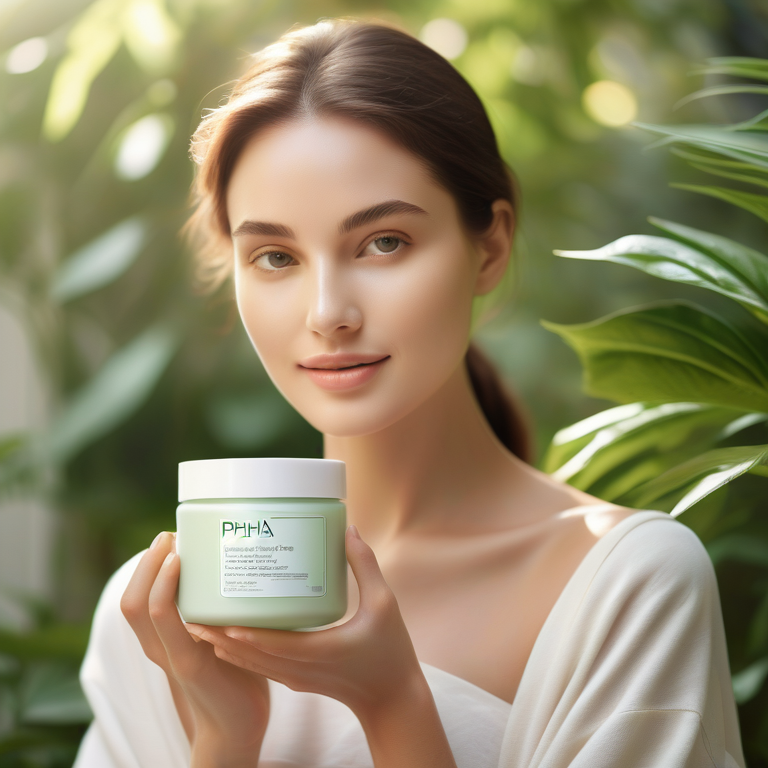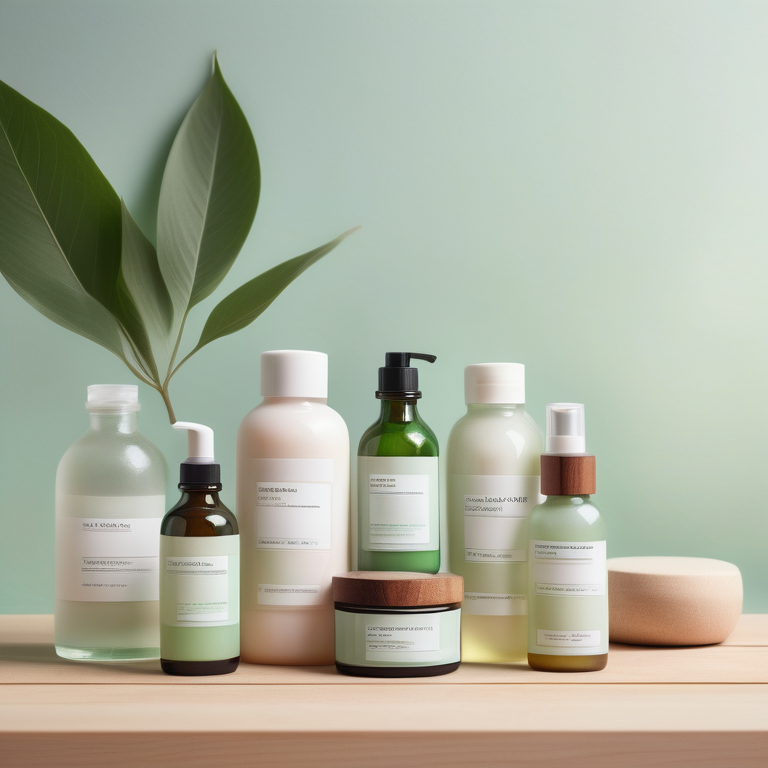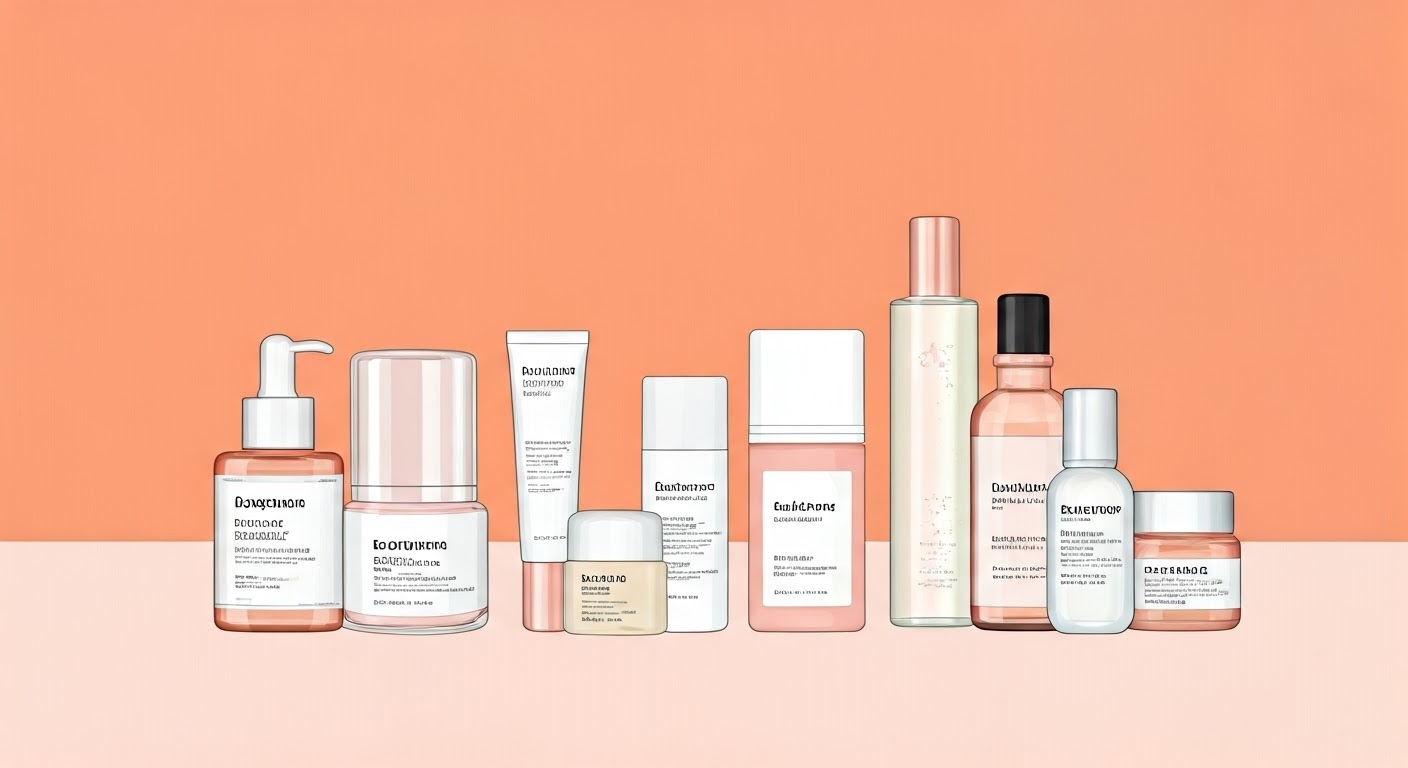What is PHA in Skin Care? Your Ultimate Guide


Introduction: What is PHA in Skin Care?
Welcome to the complete guide on polyhydroxy acids, or PHAs, which are making waves in skincare. When you're looking for that glow and smooth feel for your skin, there's a whole world of options out there. But lately, PHAs have been standing out. They're a kinder type of chemical exfoliant that can really help make your skin look and feel better without being too harsh. In this detailed guide, we'll dive into what exactly PHAs are, how they do their magic on your skin, and why adding them to your skincare routine could be just the thing you need for radiant skin.
Understanding Polyhydroxy Acids (PHAs) in Skin Care
Polyhydroxy acids, or PHAs, are a kind of chemical exfoliant that helps get rid of dead skin cells to show the fresh and healthy skin underneath. What makes PHAs different from other hydroxy acids is their bigger molecular size. Because of this larger size, PHAs don't go as deep into the skin, which means they're a softer way to exfoliate for people with sensitive skin. Even though they're gentle, PHAs still do a great job at making your complexion smoother and more polished by removing dead skin cells effectively.
What Makes PHAs Unique?
PHAs stand out from other hydroxy acids like AHAs and BHAs because of their larger molecular size. This means they just work on the top layer of your skin, making them perfect for gentle exfoliation that doesn't upset your skin. For those with sensitive skin, PHAs are a solid choice since they scrub away dead cells without causing any redness or irritation. On top of this, PHAs also help keep your skin moist and plump by drawing in water, which can help lessen the look of fine lines and wrinkles.
The Science Behind PHA Benefits for the Skin
PHAs do a lot more than just gently scrub away dead skin. They're packed with antioxidants that shield our skin from harm caused by things like UV rays and dirty air. By fighting off these harmful free radicals, PHAs keep our skin looking young and fresh. On top of that, they help keep the outer layer of our skin strong, which means we stay moisturized and lose less water through the day. This boosts how well our skin can protect itself, leading to better overall health for it. So, with their triple action of gentle exfoliation, hydration boosters, and defenders against damage from stuff like UV rays pollution , PHAs are key players in keeping your complexion glowing and healthy.
The Benefits of Incorporating PHAs into Your Routine
Adding PHAs to your skincare routine can really do wonders for your skin. By getting rid of dead skin cells, these acids make your skin feel smoother and look more polished. They help in making the color of your skin more uniform by lessening dark spots and hyperpigmentation. On top of that, PHAs hydrate and fortify the barrier of the skin, leaving it feeling plump and well-moisturized. If you keep using them regularly, they can even lessen fine lines and wrinkles, giving you a younger-looking glow.
Enhancing Skin Texture and Tone
Adding PHAs to your skincare routine can really up your game when it comes to making your skin look and feel better. Here's the scoop on how they do their magic:
- Gentle exfoliation: With PHAs, you're basically getting rid of dead skin cells in a nice way, which makes your skin smoother and nicer to touch.
- Smoothing uneven skin tone: If you've got dark spots or areas where the color seems off, PHAs can help even things out for a more uniform look.
- Promoting a healthy glow: By kicking dull and dead skin cells to the curb, PHAs leave your face looking bright and full of life.
- Refining pores: Using PHAs regularly means saying goodbye to big-looking pores. Your face will have this smooth finish that feels fresh.
So yeah, if improving how your skin looks is what you're after—texture-wise or with its overall vibe—PHA could be just what you need in your daily care kit.
Boosting Moisture and Strengthening Skin Barrier
Besides making your skin texture and tone better, PHAs are great because they help keep your skin moist and make its barrier stronger. Here's a look at how PHAs work to moisturize and shield your skin:
- Hydration: With their humectant properties, PHAs pull in moisture and hold it close to the skin. This action keeps your skin feeling soft and full.
- Strengthening the skin barrier: By helping out with the function of the skin's barrier, PHAs cut down on how much moisture is lost while also guarding against harmful stuff from outside.
- Preventing moisture-related issues: Since they boost hydration levels and fortify the protective layer of our skins, using products containing these acids can stop problems like dry patches or sensitive spots before they start.
How PHAs Compare to AHAs and BHAs
When we talk about ways to peel off dead skin using chemicals, there are a few choices like alpha hydroxy acids (AHAs), beta hydroxy acids (BHAs), and polyhydroxy acids (PHAs). Let's see how PHAs stack up against AHAs and BHAs:
- For those with sensitive skin, PHAs won't likely cause irritation as much as AHAS or BHAS might.
- In terms of sun sensitivity, while AHAS and BHAS can make your skin more prone to getting burnt by the sun, PHA’s effect on making your skin sensitive to the sun is pretty low.
- Looking at molecular size, PHA molecules are bigger than AHA or BHA molecules. This means they're gentler when it comes to exfoliating your face.
Key Differences and Similarities
To understand the differences and similarities between PHAs, AHAs, and BHAs, let's take a closer look at their properties:
|
Polyhydroxy acids (PHAs) |
Alpha hydroxy acids (AHAs) |
Beta hydroxy acids (BHAs) |
|
Larger molecular size: Provides gentle exfoliation without irritation |
Smaller molecular size: Provides deeper exfoliation |
Oil-soluble: Penetrates deep into pores |
|
Hydrating properties: Attracts and retains moisture in the skin |
Enhances natural moisturizing factors and exfoliates dead cells |
Anti-inflammatory properties: Effective for oily and acne-prone skin |
|
Antioxidant properties: Protects against free radicals |
Targets dark spots, dryness, and wrinkles |
Anti-inflammatory properties: Reduces redness and irritation |
Why PHAs Might Be Better for Sensitive Skin Types
For those with sensitive skin, PHAs are a kind choice for exfoliating without being harsh. Here's why they might just be the right pick:
- With their larger molecular size, PHAs don't go as deep into the skin, which means they're less likely to irritate.
- By offering gentle exfoliation, these acids help get rid of dead skin cells and make your skin texture smoother without making it red or overly sensitive.
- Thanks to their ability to draw moisture in and keep it there, PHA’s humectant properties ensure that sensitive skin stays hydrated and well-cared-for.
- And when it comes to sun sensitivity? PHAs barely affect it. This makes them a safer option for those whose sensitive skin easily burns or gets irritated by the sun.
Practical Tips for Using PHAs in Your Skin Care Routine
Adding PHAs to your skincare routine is pretty straightforward with these handy tips:
- With choosing the right product, aim for cleansers, toners, pads, masks, or moisturizers that have PHAs in them.
- For beginners with PHAs, it's best to start using them just a few times each week. Then you can slowly use them more often as your skin gets used to it.
- When using any product containing PHA’s make sure you always stick to what the instructions say about how and when to apply it.
Alongside other ingredients like vitamin C or hyaluronic acid; mixing these can give your skin some extra goodness.
How to Introduce PHAs to Your Skin Care Regimen
If you're thinking about adding PHAs to your skincare routine and it's all new to you, here's a step-by-step guide on how to ease them into your regimen:
- Kick things off with products that don't have too much PHA. This way, your skin can slowly get used to it.
- Before going all in and putting it on your whole face, try a little bit on just a small part of your skin. This is called a patch test, and it helps make sure you won't have any bad reactions.
- Begin by using the product once or twice every week. As time goes by and if everything looks good with no irritation or problems showing up from the use of PHAs in this initial phase; feel free then increase how often you use them based on what feels right for your skin.
- -With each application keep an eye out for any signs that might not agree with these changes like redness or feeling uncomfortable where applied - should anything seem off slow down usage immediately perhaps even take some time consult someone who knows lots about skins such as dermatologist.
Combining PHAs with Other Skin Care Ingredients
When you mix PHAs with other stuff for your skin, it can really kick things up a notch. Here's what works well together:
- With vitamin C: Using PHAs and vitamin C together is great for making your skin look brighter and better overall.
- With hyaluronic acid: If you want soft, super-moisturized skin that looks full of life, try putting PHA alongside hyaluronic acid. It gently scrubs away dead skin while locking in moisture.
- With niacinamide: This combo is awesome for smoothing out your skin’s surface, shrinking big pores, and keeping oil under control.
- With retinol: For those who don't get irritated by it, switching between PHAs and retinol could tackle lots of issues like fine lines or uneven spots on the face.
So basically mixing these ingredients with PHAs can help brighten up dullness (thanks to vitamin c), fill in those pesky fine lines, deeply moisturize (hyaluronic acid) improve how smooth our skin texture feels,gentle exfoliation, without making everything too harsh or drying out the face which helps keep an even tone across our complexion if we've got some areas darker than others (uneven tone).
Addressing Common Concerns and Myths About PHAs
A lot of people worry about using PHAs in their skincare routine, thinking it might not be safe. So, let's clear up some things:
- When we talk about PHAs that you often find in your creams and face washes, Gluconolactone, lactobionic acid, and galactose are the ones most commonly used.
- As for any bad reactions or side effects? Well, if you use them like you're supposed to, they're pretty much okay for everyone. They don't usually cause problems.
- And no matter what type of skin you have - even if it's really sensitive - PHAs should work fine for you. They help get rid of dead skin gently without making your skin upset.
- Speaking of getting rid of stuff on our faces; yes! These guys do a great job at taking away old dead cells from our surface layer which helps make our complexion look brighter and smoother.
So there we go – whether it’s dealing with those stubborn dead cells or worrying over irritation especially when having sensitive skin; including products with common phas like lactobionic acid into routines has shown promising results while ensuring gentle exfoliation across various types without harsh side effects typically associated with skincare products.
Can You Use PHAs Daily?
When thinking about adding PHAs to your daily skincare routine, it really comes down to what your skin can handle and what it needs. For all types of skin, even sensitive ones, PHAs are usually a good fit. They're not as harsh as other exfoliants like AHAs and BHAS which means they don't irritate the skin much. But remember, paying attention to how your skin feels after using them is key.
By making PHAs part of your everyday skincare, you'll see benefits that build up over time. Regularly getting rid of dead skin cells makes way for smoother and brighter-looking complexion. Plus, this helps other products in your routine do their job better since they can get into the deeper layers without any obstacles.
For those just starting with PHAs or if you've got sensitive skin on top of that list too - begin with something mild and slowly use more often from there based on how well things go along; always keeping an eye out for any signs from our body's largest organ! And when in doubt? A chat with a dermatologist never hurts before mixing new items into our care plan especially aimed at dealing with dead skins or maintaining healthy-sensitive-skin balance.
Possible Side Effects and How to Mitigate Them
While most people's skin handles PHAs just fine, some folks, especially those with sensitive skin, might notice their skin gets a bit red, feels tingly or dry when they first try out PHAs. These side effects usually don't last long and go away once your skin gets used to the new product.
To help avoid these issues:
- Start off using products with a lower amount of PHAs.
- Slowly use them more often over time.
- Always keep your skin moisturized to keep it healthy and strong.
- Try not to mix PHA products with other stuff that can irritate your skin like vitamin C or retinol. This helps cut down on any negative reactions.
Also, remember that using PHAs can make you more likely to get sunburned. So it's super important to put on sunscreen every day that protects against all types of harmful UV rays from the sun.
Advanced Tips for Experienced PHA Users
For those who've been using PHA and want to step up their skincare game, there are some cool tips you might wanna try out. Before diving into cosmetic procedures like chemical peels or microdermabrasion, it's key to chat with a certified dermatologist or someone who knows skin well. They can check out your skin type and figure out what treatments will work best for you.
On top of that, mixing PHAs with other acids in your skincare routine could really help with specific issues your skin might have. But remember, it's super important to take things slow when trying new stuff on your face to keep irritation at bay. Make sure you're sticking to the directions given by the folks who made the product and pay attention to how your skin feels.
Layering PHAs with Other Acids
Mixing PHAs with other acids in your skincare routine can really step up the game by peeling off dead skin and tackling various skin issues. But, it's key to know how these different acids get along and think about how they fit with your skin's natural balance.
With acid layering, you usually want to begin with the one that has the lowest pH before moving on to those with higher levels. This method lets each acid do its job without causing any unwanted irritation.
For instance, kicking things off with a PHA-based product then moving onto ones containing AHAs or BHAs could be great for dealing with uneven skin tone, rough texture, or blemish-prone skin. Just make sure you're paying attention to how your skin reacts and tweak things if needed because no one likes feeling uncomfortable or irritated.
If mixing acids feels like uncharted territory or if figuring out where they fit into your skincare routine seems daunting, getting advice from a dermatologist or a skincare expert is always smart. They can offer tips tailored just for you.
Seasonal Adjustments in Your PHA Routine
As the seasons change, so do what your skin needs. With summer bringing more sun our way, it's super important to not skimp on sunscreen. Make sure you're using one that protects against all types of sun rays and has a strong SPF. Don't forget to put more on every few hours.
When winter rolls around and the air gets drier, keeping your skin moist becomes key. Look for moisturizers or products with stuff in them that pulls water into your skin - these have humectant properties and are great for stopping dryness from taking over.
Also, think about how humid or dry it is where you live because this can make your skin oily or too dry. You might need to use PHA products less often if there's a lot of moisture in the air since they could be too harsh otherwise.
It’s always good to pay attention to what your skincare routine does during different times of year and tweak things as necessary. If figuring out how best to switch things up seems tricky, getting advice from someone who knows lots about skincare can really help.
Conclusion
Polyhydroxy Acids, or PHAs for short, are really kind to your skin and work well for all types, especially if you have sensitive skin. They help make your skin feel smoother, keep it moisturized, and strengthen the skin barrier. What makes PHAs so special is how they manage to exfoliate without causing any harshness. If you're thinking about adding PHAs into your skincare routine, it's important to know what sets them apart from other acids like AHAs and BHAs and get some tips on how best to use them. It's also good to clear up any misunderstandings about these acids so that you can be fully in the loop. By staying informed and trying things out carefully, you'll see a nice glow in your skin texture thanks to PHA-based products.
Frequently Asked Questions
What does PHA do to your skin?
PHAs work by getting rid of dead skin cells that sit on the top layer. By doing this, they uncover healthier and more glowing skin underneath. This process can make your skin look better overall, giving it a brighter appearance and glow.
Is pha better than AHA?
PHAs and AHAs both do a great job at exfoliating the skin, but for people with sensitive skin, PHAs are usually seen as the better choice. They're less likely to irritate and work well for folks who've found AHAs too harsh in the past.
Is it OK to use PHA everyday?
Incorporating PHAs into your daily routine can be both safe and good for a lot of people. They help with gentle exfoliation while also taking care of the skin's protective barrier. But, it's crucial to pay attention to how your skin reacts and make changes if you notice any irritation or sensitivity.
What is an example of a PHA?
In the world of skincare, you'll often come across ingredients like gluconic acid and lactobionic acid. These components are tucked away in many products we use daily to take care of our skin, from cleansers and toners to masks and moisturizers. They play a big part in keeping our skin looking its best.
How long does it take to see results from using PHAs?
When you start using PHAs, the effects might differ based on your own skin type and what issues you're dealing with. But if you keep at it regularly, over time, there's a good chance you'll see some positive changes in how smooth your skin feels and in reducing the look of fine lines.
Are there any skin conditions that should avoid PHAs?
For those with sensitive skin or certain skin conditions, it's usually okay to use PHAs since they're pretty gentle. However, before adding PHAs to your skincare routine, chatting with a dermatologist is a smart move. With their help, you can get advice and directions that fit just right for you.




